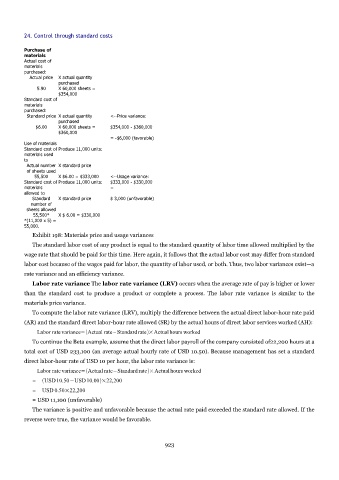Page 922 - Accounting Principles (A Business Perspective)
P. 922
24. Control through standard costs
Purchase of
materials
Actual cost of
materials
purchased:
Actual price X actual quantity
purchased
5.90 X 60,000 sheets =
$354,000
Standard cost of
materials
purchased:
Standard price X actual quantity <--Price variance:
purchased
$6.00 X 60,000 sheets = $354,000 - $360,000
$360,000
= -$6,000 (favorable)
Use of materials
Standard cost of Produce 11,000 units:
materials used
to
Actual number X standard price
of sheets used
55,500 X $6.00 = $333,000 <--Usage variance:
Standard cost of Produce 11,000 units: $333,000 - $330,000
materials =
allowed to
Standard X standard price $ 3,000 (unfavorable)
number of
sheets allowed
55,500* X $ 6.00 = $330,000
*(11,000 x 5) =
55,000.
Exhibit 198: Materials price and usage variances
The standard labor cost of any product is equal to the standard quantity of labor time allowed multiplied by the
wage rate that should be paid for this time. Here again, it follows that the actual labor cost may differ from standard
labor cost because of the wages paid for labor, the quantity of labor used, or both. Thus, two labor variances exist—a
rate variance and an efficiency variance.
Labor rate variance The labor rate variance (LRV) occurs when the average rate of pay is higher or lower
than the standard cost to produce a product or complete a process. The labor rate variance is similar to the
materials price variance.
To compute the labor rate variance (LRV), multiply the difference between the actual direct labor-hour rate paid
(AR) and the standard direct labor-hour rate allowed (SR) by the actual hours of direct labor services worked (AH):
Labor rate variance=Actual rate – Standardrate×Actualhours worked
To continue the Beta example, assume that the direct labor payroll of the company consisted of22,200 hours at a
total cost of USD 233,100 (an average actual hourly rate of USD 10.50). Because management has set a standard
direct labor-hour rate of USD 10 per hour, the labor rate variance is:
Labor rate variance=Actual rate – Standard rate×Actualhours worked
= USD10.50−USD10.00×22,200
= USD 0.50×22,200
= USD 11,100 (unfavorable)
The variance is positive and unfavorable because the actual rate paid exceeded the standard rate allowed. If the
reverse were true, the variance would be favorable.
923

